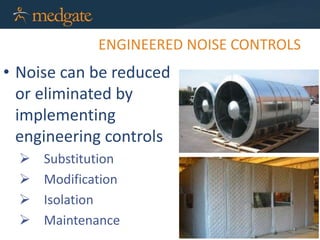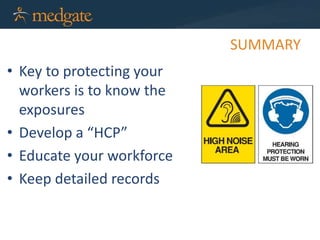NIHL Australia - Slides
- 2. 1. WHAT IS NOISE & HOW DO WE HEAR 2. OCCUPATIONAL EXPOSURE LIMITS 3. HEALTH EFFECTS 4. HEARING CONSERVATION PROGRAMS Dan Morrison Marketing Coordinator Kerri-Ann Jessep, COH Client Service Consultant
- 3. KERRI-ANN – INTRODUCTION • Certified Occupational Hygienist • Full Member of the AIOH • Worked for 16 years in mining, mostly in the aluminium industry, as an Occupational Hygienist, 2 years in EHS consulting, and 14 years in the power industry as a Scientific Technical Officer • Client Service Consultant, assist clients with Medgate implementation, for 2 ½ years
- 4. OVERVIEW • What is noise? • How do we hear? • Occupational Exposures Limits (OELs) • Health Effects of Hearing Loss • Developing a Hearing Conservation Program • Proactive Programs
- 5. Worldwide, 360 million people today have moderate to profound hearing loss due to various causes, such as noise, genetic conditions, complications at birth, certain infectious diseases, chronic ear infections, the use of particular drugs, and ageing . It is estimated that half of all cases of hearing loss are avoidable. World Health Organization “ ”
- 6. Noise induced hearing loss is the most common permanent and preventable occupational injury in the world. World Health Organization “ ”
- 7. • Between July 2002 and June 2007, there were about 16,500 successful workers’ compensation claims for industrial deafness involving permanent impairment due to noise. • Economic burden of occupational NIHL is borne by workers and their families, business owners and managers, and the wider society. [Reference: Safe Work Australia, Occupational Noise-Induced Hearing Loss in Australia – Overcoming barriers to effective noise control and hearing loss prevention, August 2010] IN AUSTRALIA
- 8. OCCUPATIONAL NOISE INDUCED HEARING LOSS • Usually from long-term exposure • Temporary or permanent • Initially effects high frequencies Speech recognition • Cannot be treated or corrected NIHL is permanent, but it is preventable
- 9. WHAT IS SOUND? • Vibrations transmitted through air, water or other material that the ear and brain can respond to • Large range of frequencies and pitches
- 10. SOUND AND NOISE • Sound is a pressure change detectable by the human ear: Frequency range between 20 – 20, 000 Hz Loudness range between 0 – 140 dB • Noise is a type of sound Generally described as unwanted or undesirable sound
- 11. HOW WE HEAR Conversion of vibrations to electrical impulses in nerves connected to the brain
- 12. A-WEIGHTING • Provides a single number measure of noise level by integrating sound levels at all frequencies • Gives a scale for noise level as experienced or perceived by the human ear • LAeq, LAE, LAFmax
- 13. C-WEIGHTING • C-weighting is used in noise assessment for the evaluation of impulse noise and for hearing protection devices • LCeq, LCPeak
- 14. Z-WEIGHTING • Z-weighting has been recently introduced and is a flat frequency response over the usual range of measurements for noise assessments • LZeq, LZFmax, LZE
- 15. WORKING WITH DECIBELS Change in dB Change in sound energy 3 dB increase Sound energy doubled 3 dB decrease Sound energy halved 6 dB increase Sound energy is quadrupled 9 dB increase Sound energy increased by factor of 8
- 16. ADDING NOISE LEVELSNumerical difference between two noise levels [dB] Amount to be added to the higher of the 2 noise levels [dB] 0 3.0 1 2.5 2 2.1 3 1.8 4 1.5 5 1.2 6 1.0 7 0.8 8 0.6 9 0.5 10 0.4 >10 0 Difference in Levels Amount to be added to the higher level 0, 1 +3 2, 3 +2 4 - 9 +1 10 + 0
- 17. HEALTH EFFECTS • The risks of hearing loss are often ignored by workers due to: Hearing loss causes no pain The loss can occur gradually, so that exposed workers do not notice the loss until significant damage has occurred or is picked up during a hearing test Hearing loss is permanent & non-reversible
- 18. AUDITORY HEALTH EFFECTS • Temporary or permanent • Hearing loss – prolonged exposure to noise • Usually bilateral and symmetrical • Young and older workers
- 19. NON-AUDITORY EFFECTS • Social isolation • Impaired communication • Decreased ability to monitor the work environment • Increased injuries & poor health • Anxiety & irritability • Decreased self-esteem • Lost productivity • Expenses for worker’s compensation & hearing aids
- 20. NOISE IN THE WORKPLACE • Is my workplace too loud? Is the noise intrusive? Raise voice to communicate Noisy tools / machinery Noisy industry Noise due to impacts Worker’s experience temporary hearing loss when leaving work
- 21. HOW LOUD IS TOO LOUD? • Occupational exposure standards for noise exposure can vary by country and state / region • In Australia: LAeq,8h of 85 dB(A) LC,peak of 140 dB(C) • In New Zealand: LAeq,8h of 85 dB(A) Lpeak of 140 dB
- 22. ALLOWABLE LEVELS AND DAILY DURATION Noise OEL = 85 dB(A) 3 dB(A) Exchange Rate Allowable Level dB(A) Maximum Permitted Daily Duration (hours) 94 1 91 2 88 4 85 8 82 16
- 23. NOISE AND ACCIDENTS • Elevated noise levels may result in higher accident rates due to: Unable to hear warning alarms Interfere with ability to hear safety instructions Distractive, hamper ability to focus
- 24. HEARING CONSERVATION PROGRAM Identify Noise Hazards Exposure Monitoring Assessment and Corrective Actions Hazard Communication Training Periodic Review
- 25. HEARING CONSERVATION PROGRAM • Noise Measurement / Exposure Monitoring • Noise Control Engineering / Administrative / PPE • Hazard Communication • Hearing Protection Devices • Education and Training Health effects of noise Use, care and fit of hearing protection Procedures and policies • Audiometric Testing • Annual program review
- 26. HEARING CONSERVATION PROGRAM 1. Review work areas, processes and operations 2. Observe workers and tasks completed during shift 3. Identify areas in the workplace where high noise levels exist 4. Identify workers that may be exposed 5. Document assessments Identify Noise Hazards => Qualitative Assessment for Noise
- 27. MANAGING WORKPLACE EXPOSURE Recognise Assess Control Evaluate
- 28. EXPOSURE MONITORING • Identify and monitor areas with high noise levels • Identify employees who may be exposed to levels exceeding OEL
- 29. EXPOSURE MONITORING • Identify areas with high noise levels Review equipment specs Review historical data Talk to workers Observe tasks Walk-through survey
- 30. NOISE MEASUREMENT • Map noise sources • Note equipment on and off at the time of the survey
- 31. EXPOSURE MONITORING • Area Noise Level Measurements: Indicate level of noise in the area at the time of the measurement Sound Level Meter (SLM) **NOTE – take more than one reading as sound levels may vary under different conditions
- 32. EXPOSURE MONITORING • Personal Exposure Measurements Track exposure to noise over time Noise Dosimeter **NOTE – take more than one reading – sound levels may vary
- 33. OCTAVE BAND ANALYSIS • Assist in selecting the appropriate engineering controls to reduce noise levels
- 34. ASSESSMENT OF OCCUPATIONAL EXPOSURES Start Basic Characterisation Exposure Assessment Unacceptable Exposure Uncertain Acceptable Exposure Reassessment Control Further Information Gathering
- 35. EXPOSURE MONITORING • Any employee exposed to the noise OEL or higher must be enrolled in the HCP • Re-assess high level areas Each employee or, SEG dosimetry sampling • Re-assess when significant change occurs Change of process Change of controls New piece of equipment
- 36. SIMILAR EXPOSURE GROUPS (SEGS) • Identify workers to be included in Hearing Conservation SEG • Track over time • Set up recall for audiometric testing • Noise monitoring results • Hearing fit test results • Training and education records
- 37. SIMILAR EXPOSURE GROUPS (SEGS) • Eligibility • Identification • Enrollment • Termination
- 38. EMPLOYEE NOTIFICATION • Employees must be notified of their sample results in a timely manner • Personal letters • Posting results
- 39. EQUIPMENT • Care and maintenance of equipment • Calibration before and after use • Annual calibration: Certificates of calibration
- 40. NOISE CONTROLS • Hierarchy of controls Elimination Substitution Engineering Controls Administrative Controls PPE
- 41. ENGINEERED NOISE CONTROLS • Noise can be reduced or eliminated by implementing engineering controls Substitution Modification Isolation Maintenance
- 42. ADMINISTRATIVE NOISE CONTROLS • Rotation • Procedural changes
- 43. CONTROL IMPLEMENTATION • All assessments conducted and actions taken should be documented: Monitoring data Controls PPE SEG enrollment • Risk Assessments
- 44. HEARING PROTECTION DEVICES • Last option to control noise exposure • Must be made available to employees • Must be properly fitted and used • Use must be enforced in required areas
- 45. HEARING PROTECTION DEVICES • Classification Method, Sound Level Conversation, & Octave Band Method Use the AS/NZS Classification Method when choosing hearing protectors Simple 5 class system Wearing time is important in obtaining protection, as well as comfort, fit, care, maintenance, and applicability to the work area, processes and tasks NOTE: Sound Level Conversion (SLC) rating was used until 2005.
- 46. AS/NZS CLASS HEARING PROTECTION LAeq,8h dB(A) Class SLC80 Less than 90 1 10 – 13 90 to < 95 2 14 – 17 95 to < 100 3 18 – 21 100 to < 105 4 22 – 25 105 to < 110 5 > 26 110 or greater Requires specialist advice (i.e. double hearing protection)
- 47. TRAINING OF THE WORKFORCE • Hazards and health effects of noise • Control measures in place to reduce exposure • Reasons for Hearing Fit Testing and Audiometric Testing • Proper use of PPE • Review of HCP • Annual sessions
- 48. HAZARD COMMUNICATION • Areas above OEL - warning signs should be posted A noise hazard exists Hearing protection must be worn
- 49. AUDIOMETRIC TESTING • Ensures your program is effective • Identify when hearing loss has occurred • Baseline and annual audiograms • Standard Threshold Shifts • Provide education
- 50. THRESHOLD SHIFTS • Temporary Threshold Shifts (TTS) Hearing returns to normal after time once removed from the source • Permanent Threshold Shifts (PTS) Progresses constantly as exposure continues over time • Standard Threshold Shifts (STS) >10 dB average loss in 2, 3, or 4 kHz in either ear • Significant Threshold Shift Intervention
- 51. RECORD KEEPING • Access to Records & Documents • Risk Management Plan • Hazard Identification and Hazard Control Assessments • Exposure Measurements • Hearing Protection Program • Audiometric Test Records • Document Retention Periods
- 52. PROGRAM AUDIT • Annual review • Effectiveness of program • Each component of program • Third party
- 53. BUY QUIET • Prevention initiative • Purchase or rent quieter equipment and tools • Encourages manufacturers to design quieter equipment • Create a demand
- 54. BUY QUIET • Different noise levels from different manufacturers – same equipment Manufacturer A 107 dB(A) Manufacturer B 96 dB(A)
- 55. BUY QUIET • Benefits: Reduce risk of hearing loss Reduce long-term costs of audiometric testing, PPE, workers compensation Comply with noise regulations Protect your workers
- 56. BUY QUIET • Implement a “Buy Quiet” program Educate buyers on NIHL Develop a Noise Buying Procedure Engineering noise controls should be considered in the design phase of new plant and processes Encourage buyers to seek out equipment with lower dBs Lobby manufacturers for quieter equipment
- 57. SUMMARY • Key to protecting your workers is to know the exposures • Develop a “HCP” • Educate your workforce • Keep detailed records
- 58. NOISE-INDUCED HEARING LOSS Causes no pain Causes no visible trauma Leaves no visible scars Is unnoticeable in its earliest stages Accumulates with every overexposure Takes years to notice a change Is Permanent & Preventable
- 59. TO FIND OUT MORE ABOUT PROTECTING YOUR WORKERS FROM NOISE INDUCED HEARING LOSS, FOLLOW THIS LINK

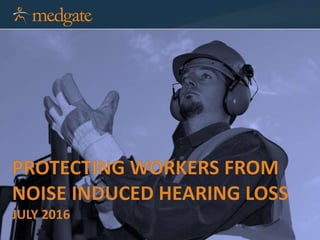

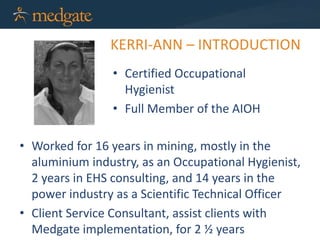
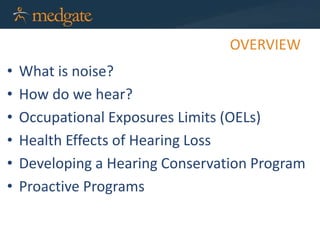
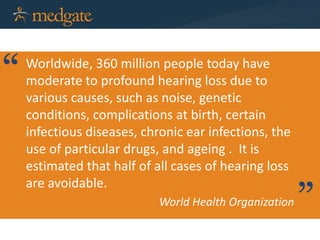

![• Between July 2002 and June 2007, there were
about 16,500 successful workers’
compensation claims for industrial deafness
involving permanent impairment due to noise.
• Economic burden of occupational NIHL is
borne by workers and their families, business
owners and managers, and the wider society.
[Reference: Safe Work Australia, Occupational Noise-Induced Hearing Loss in Australia –
Overcoming barriers to effective noise control and hearing loss prevention, August 2010]
IN AUSTRALIA](https://image.slidesharecdn.com/nihlausslideshare-160721214417/85/NIHL-Australia-Slides-7-320.jpg)
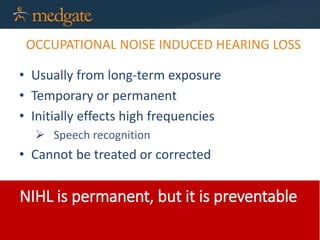

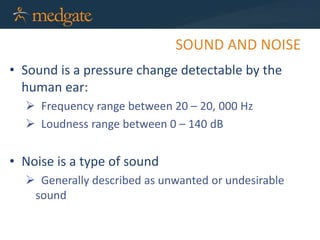





![ADDING NOISE LEVELSNumerical
difference between
two noise levels
[dB]
Amount to be added
to the higher of the
2 noise levels
[dB]
0 3.0
1 2.5
2 2.1
3 1.8
4 1.5
5 1.2
6 1.0
7 0.8
8 0.6
9 0.5
10 0.4
>10 0
Difference
in Levels
Amount to be added to
the higher level
0, 1 +3
2, 3 +2
4 - 9 +1
10 + 0](https://image.slidesharecdn.com/nihlausslideshare-160721214417/85/NIHL-Australia-Slides-16-320.jpg)
























